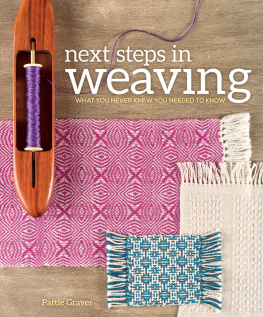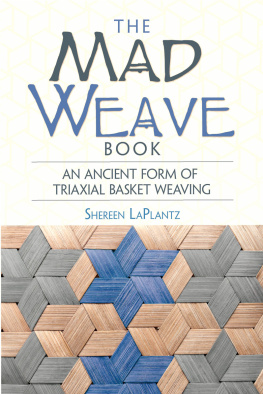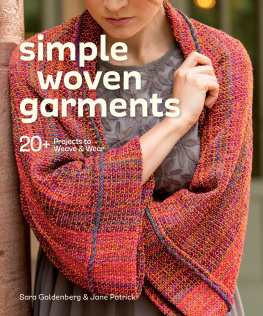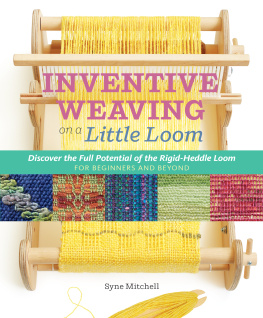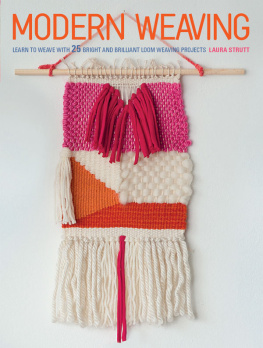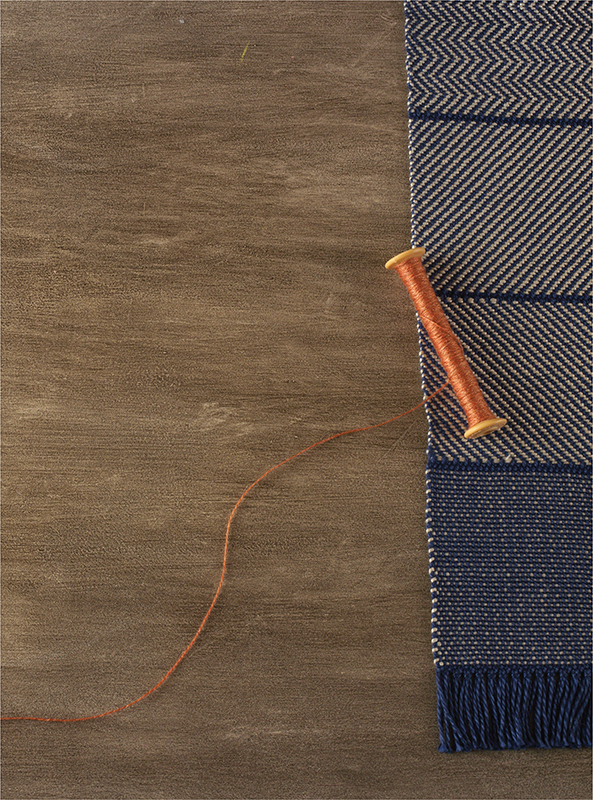Contents
Guide
Pattie Graver

Table of Contents
Introduction
Dearest reader,
Thank you for your interest in Next Steps in Weaving. I think its safe to say that once you learn how to warp a loom and some other basics, youll marvel at how much there is to discover in the great world of handweaving. Many are able to dive right in with incredible confidence and, from the very beginning, identify themselves as weavers; I admire those people. For some of us, its difficult to decide where to start the exploration; we want to do it all. We may let in noise that causes us to think that we need to wait for some magical moment before allowing ourselves to weave certain structures, graduate to more shafts, or weave with certain fibers or setts.
In my case, I wove for more than fifteen years before I became a weaver; that is, before I was able to progress from knowing how to knowing why. I designed my own successful twill projects and executed one piece after another without understanding anything about weave structures. I was just eager to get something on the loom and weave. When I considered a new topic, I often found it difficult to locate books and articles that presented the information in a way I could understand. I always seemed to be missing something, and my desire to get to weaving was far stronger than any longing to understand weave structures. Like many, I looked at weaving as a contemplative activity that allowed me to get into my head and solve the problems of the world while sitting at my loom. Thats still a huge part of my weaving experience.
Things began to broaden for me when I first attended Madelyn van der Hoogts Weavers School on Whidbey Island, Washington. It was there that I gained experience beyond twill and, although a curiosity was born, I still didnt understand anything about structure. I believed that other weavers had a weaving gene or were born with an instinct that had skipped me; I was content with my ability to weave an expanded repertoire of weave structures as long as I had a draft, tie-up, and treadling instructions.
Soon after, I found myself working at Interweave. As managing editor of Handwoven magazine, I had the opportunity to work with and learn from Madelyn on a daily basis, and I also had to answer questions for readers. I found that most questions came from weavers like me who felt they were missing elemental bits of information that prohibited greater technical comprehension. I empathized with the callers who apologized for having dumb questions, and I quickly came to recognize the fallacy in this declaration. Out of necessity, I began to find ways to fill in the gaps of my own weaving knowledge to help these readers. I loved sharing what I knew about weaving. One evening over dinner with a dear friend, I found the idea for this book in a very fine glass of wine.
Next Steps in Weaving focuses on fundamental weaving concepts and offers a direction of study with the opportunity to experience a variety of weaves and variations; it will help you dive in and become a weaver. By reading the chapters and weaving the samplers and projects, youll acquire a solid understanding of the concepts presented in this book. Ive tried to include all the information I longed for when I was ready to move beyond twill. For example, I had learned the basics of overshot, but I had no idea what it meant to weave it on opposites or as a star or rose.
In writing this book, Ive assumed that readers have elemental weaving skills that include familiarity with basic weaving terminology, as well as experience warping a loom and weaving at least a few projects in plain weave or simple twills. Although all of the practice samples and projects in this book are woven on four shafts, much of the information applies to eight shafts as well.
The world of weaving is vast and, through this book, I offer an approach that will enhance your know how with know why. I dont believe in a one-size-fits-all approach with regard to all the tasks that support weaving. When presented with ideas, I think you should evaluate the options and choose what works for you. However, I do think that certain habits are common to successful weaving. For example, you always want a warp with even tension, you always want a tightly wound bobbin, and the best predictor of a projects outcome is a sample.
Among my dear co-workers at Interweave, I found the most supportive environment of my entire adult work-life experience. I was blessed to work with people who wanted each other to succeed. Its in that spirit that I wish to share with you what I know about weaving. Allow your individuality to shine. This is just weaving, and its just wonderful.
Stay warped,
Pattie
Chapter 1
Learning with Twill
To grow your weaving skills, youve got to weave and begin to focus on the process. Basic four-shaft twills are easy to understand and give you the opportunity to become comfortable with some of the mechanical and technical aspects of weaving. In addition to learning the basics of twill in this chapter, Ill review some things you may be familiar with, such as reading drafts and using floating selvedges. Ill also offer general tips for warping and weaving.

